|
Visit our keyboard shortcuts docs for details
View of the steam rising from Steamboat Geyser after an eruption earlier in the day. Tucked away in the Norris Geyser Basin is Steamboat Geyser, the world’s tallest active geyser. Its major eruptions shoot water more than 300 feet (91 m). Only Waimangu Geyser in New Zealand has rocketed to greater heights—but not in more than one hundred years. In Yellowstone National Park’s recorded history, only two other geysers have exceeded Steamboat in size: Excelsior Geyser in Midway Geyser Basin and Sapphire Pool in Biscuit Basin. Steamboat’s minor and major eruptions are entirely unpredictable. 
NPS/Dave Krueger Major Eruptions—Rare and SpectacularA major eruption of Steamboat Geyser is unforgettable. Water surges from two vents to varying heights, then suddenly water is expelled to more than 300 feet (91 m) high. Curtains of water fall to the slope above the geyser and collect in torrents rushing back into the vents, carrying huge amounts of mud, sand, and rock that are shot skyward again and again. Water coats everything with a glistening layer of silica. A significant amount of eruption debris can accumulate around the geyser. Even cars in the parking area can be littered with debris. Mature lodgepole pines have been broken by the downpour, undermined and then washed away by the geyser’s massive discharge. The boardwalk at the base of the hill has been covered by the geyser’s outwash. The water phase of a major eruption lasts 3 to more than 40 minutes. Once the water supply is exhausted, the geyser continues with a powerful steam phase lasting several hours to several days. Its roar is so great that conversation near the geyser is difficult, and visitors in the Norris Campground, a mile to the north, have been awakened by the noise. Not-so-minor EruptionsSteamboat’s minor eruptions are most common and reach 6–40 ft (2–12 m) and last 1–4 minutes. Intervals may be as short as 2–5 minutes. The higher and longer minor eruptions often excite viewers because a major eruption seems imminent, with water expelling from both the larger north vent and its smaller counterpart. Usually, the geyser quickly calms down again. 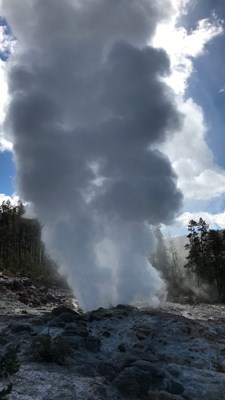
NPS/Dave Krueger Dormancy and RejuvenationThe 1959 Hebgen Lake Earthquake, 7.5 on the Richter Scale, was centered outside the western boundary of Yellowstone. Two years later, for the first time in 50 years, Steamboat Geyser erupted. Some scientists believe this rejuvenation was a direct result of thermal energy shifts caused by the 1959 earthquake; others say it was coincidental. As of this day there is still no clear correlation between Steamboat’s eruptions and earthquake activity. Over the years, Steamboat’s eruptions have been sporadic. Some years saw frequent eruptions, such as 1982–1983, when dozens of eruptions occurred. Quiet periods throughout the 1990’s and late 2000’s were marked by years of dormancy between single eruptions. One thing is known, Steamboat Geyser’s future eruptions will continue to be unpredictable. Steamboat began an eruptive period on March 15, 2018, after a more than 3.5-year dormancy. The geyser has been erupting somewhat regularly (but not predictably) since that date. The dynamic nature of this geyser basin, and the geology of Yellowstone as a whole, keeps everyone guessing. 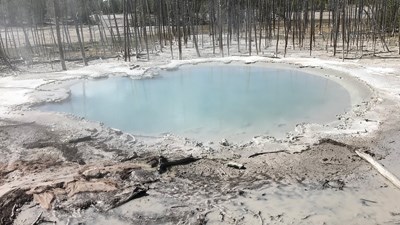
NPS/Dave Krueger The Cistern Spring ConnectionCistern Spring, at the base of the hill, exhibits changes related to its gigantic neighbor. After 1959, Cistern Spring’s temperature gradually rose, possibly receiving some of this heat from Steamboat. Cistern’s discharge increased in 1965, when Steamboat’s major eruptions were becoming less frequent. This surge in heat and water was so great that all vegetation immediately south of Cistern was killed, and a colorful silica terrace rapidly grew several feet high. This terrace continues to rise and expand. Since then, Cistern has also drained during or after a major Steamboat eruption. Steamboat’s Major EruptionsAll recorded major eruptions are listed here. Others may have occurred, but were not necessarily seen if there were no observers in Norris Geyser Basin. The intervals range from 3 days to 50 years. The largest number of recorded eruptions in a year occurred twice, with 48 eruptions in both 2019 and 2020.
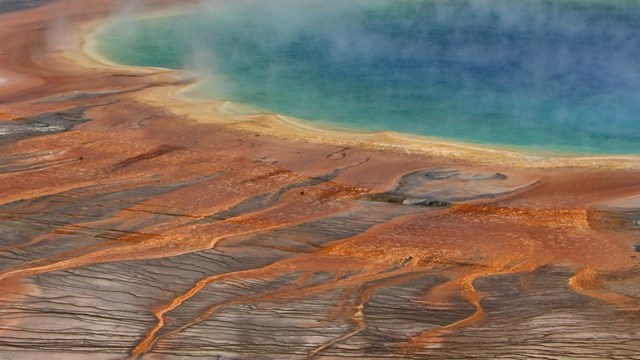
Hydrothermal Systems
Yellowstone's hydrothermal systems are the visible expression of the immense Yellowstone volcano. 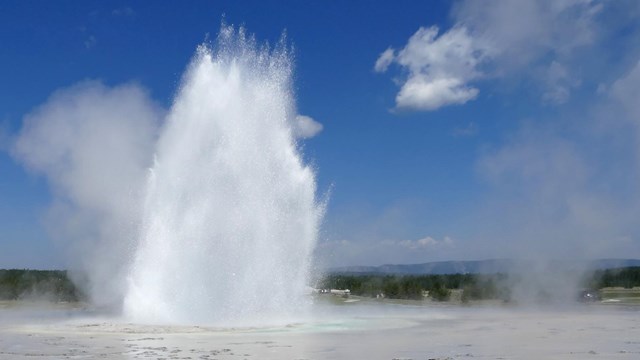
Hydrothermal Features
Yellowstone preserves earth's most extraordinary collection of hot springs, geysers, mudpots, fumaroles, and travertine terraces. 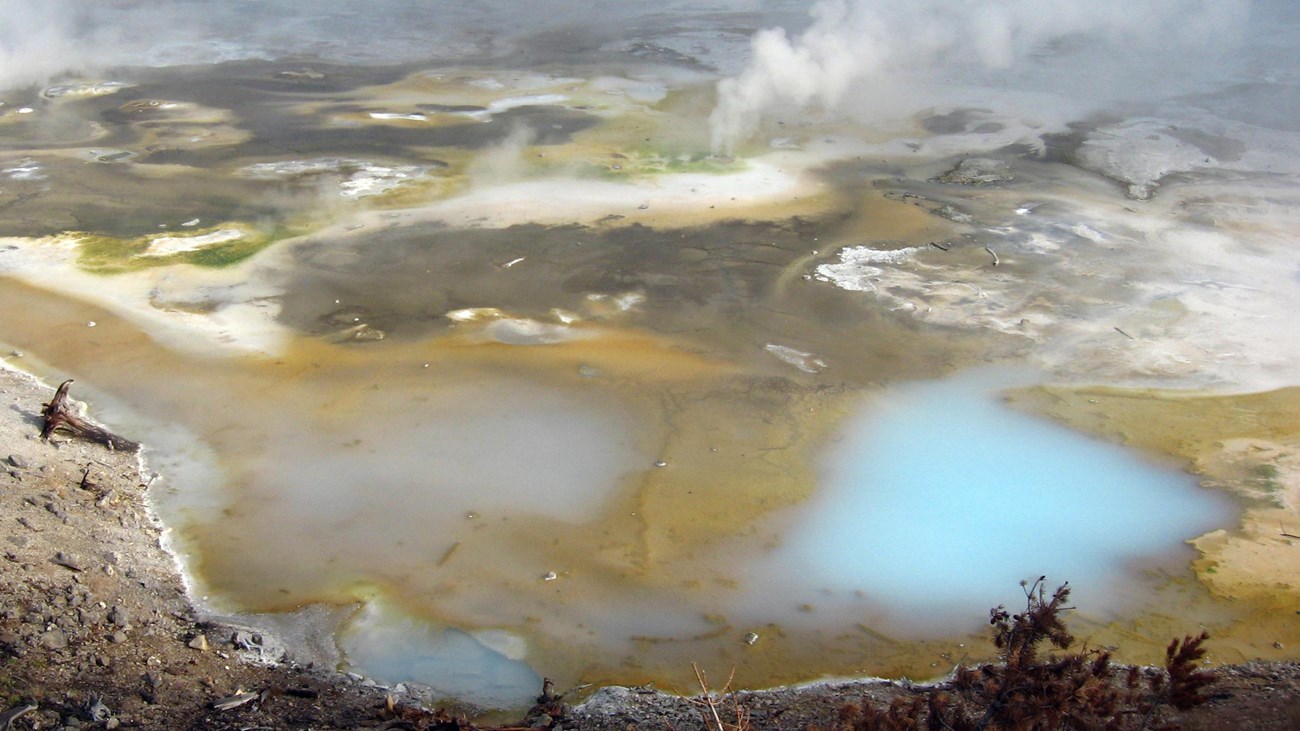
Norris Geyser Basin
Take a virtual trip around the hottest geyser basin in the park, then plan a visit in person. 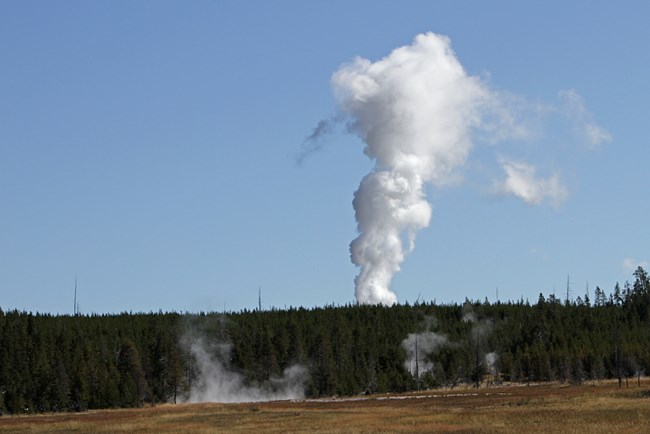
NPS/Jim Peaco Steamboat's Major EruptionsThe intervals between Steamboat's major eruptions range from 3 days to 50 years. The largest number of recorded eruptions in a year occurred in 2019, with 48 eruptions. Beginning in March, 2018 Steamboat entered an ongoing period of more frequent major eruptions. Though major eruptions have recently been more numerous, Steamboat is still unpredictable. The interval between eruptions during this period of activity has ranged from as little as three days to over two weeks.Below is a list of historic Steamboat eruptions through mid-July, 2020. Visit GeyserTimes for a record of recent Steamboat major eruptions. |
Last updated: April 17, 2025
